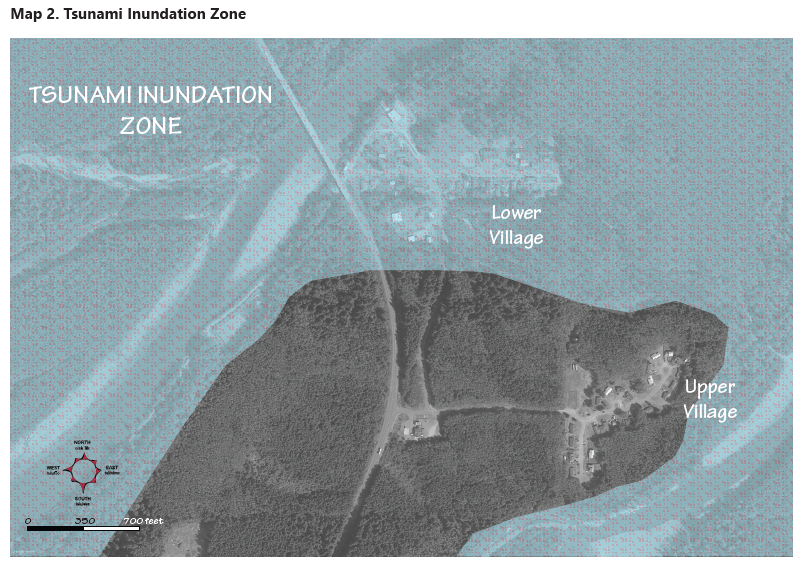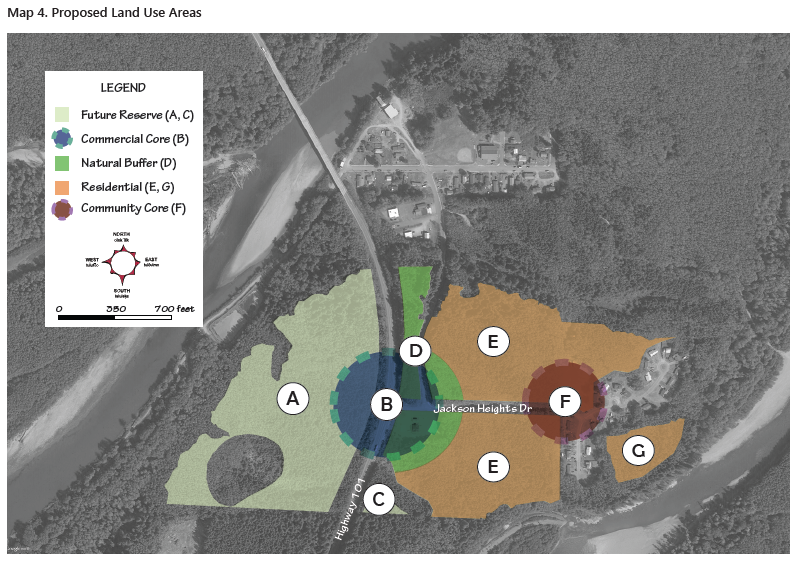Queets
The vision document outlines a community-informed plan for the relocation of the Lower Village of Queets, WA outside of the tsunami inundation zone.
The risks to Queets include sea level rise, earthquakes and tsunamis caused by the Cascadia Subduction Zone. Queets already experiences minor flooding during storm. In the event of major earthquake, the Lower Village could be inundated by up to 50 feet of water.
Approximately 25 homes and 11 community and tribal government buildings are located in the Lower Village.
The Lower Village would be completely inundated in the event of a tsunami. (Ripple Planning, 2018, p.31)
Adaptation and Mitigation
Mitigation strategies for Queets are introduced and outlined in the Quinault Indian Reservation Tribal Hazards Mitigation Plan. These actions include the development and adoption of Community Emergency Management Plans, Standard Operating Procedures and Emergency Operating Procedures, Climate Change Vulnerability Assessments, and training of staff in mitigation and emergency response.
Project Initiation
The Queets Relocation Vision was developed as a University of Portland’s master’s degree project in Urban and Regional Planning.
Land Suitability for Future Queets (Ripple Planning, 2018, p.36)
Process
As part of the Queets planning process, a technical analysis was done to show the available buildable land deemed safe from flooding. A land suitability analysis was undertaken.
The purpose of the community engagement was twofold: 1) to act as facilitators in conducting a process in which people felt respected and concerns were acknowledged; and through that process 2) to collect input to shape the Queets Village Relocation Plan.
The community feedback was incorporated into framework maps providing a high-level understanding of what a new village could look and how it could operate.
Community Engagement
The Queets project prioritized the voice of the community. The community engagement activities included community dinners, discussion groups, breakfasts with seniors, interviews, tabling in high-traffic locations, online and printed surveys, door-to-door house visits, tours of village sites and participating in community activities.
After getting to know the site and the community, the team began sketching a future village design through several discussion group activities. As a result of different informal and formal engagement opportunities, the vision began to take shape.
The vision was then clarified by presenting the findings to the community in order to receive feedback.
Key takeaways from community engagement activities (Ripple Planning, 2018, p.44)
Key takeaways from community engagement activities (Ripple Planning, 2018, p.45)
Outcomes
The research and feedback heard from the Queets community informed the development of design guidelines and recommendations to be used by future planners and community members in future relocation development.
While community residents explored multiple scenarios, there seemed to be community agreement on a core set of design principles:
Keep new housing close to existing housing so families can be together.
Build primarily single-family homes with large lots providing ample privacy, but still provide a diversity of other housing options for different household compositions.
Separate public, outside-facing uses (meant for visitors to Queets) from private, community-facing uses (meant for Queets residents).
Create safe streets and roads to accommodate for people driving, walking, in wheelchairs, on bike, and using other forms of transportation.
Proposed land use areas for a relocated Lower Village (Ripple Planning, 2018, p.48)
In addition to proposing framework maps, the vision plan contains recommendations for future planners based on feedback heard during community engagement. These are broken down into goals and actions.
Goals reflect common, broad themes that continually emerged in conversations with the community. They include:
Connection to Nature
Design for Community
Quality Housing for All
Economic Opportunity
Transportation Network
Quality of Life
Emergency Preparedness
These goals are then broken down into a series of actions. Ratings of community interest and positive impacts are indicated by the circles on the left hand side of the actions. Justifications for the actions are provided in more detail in the report on the page indicated in the images below. The full report can be accessed by clicking here.
References:
Ripple Planning. (2018) Queets Village Relocation Vision: A Community Vision for a Safe Future Queets.












